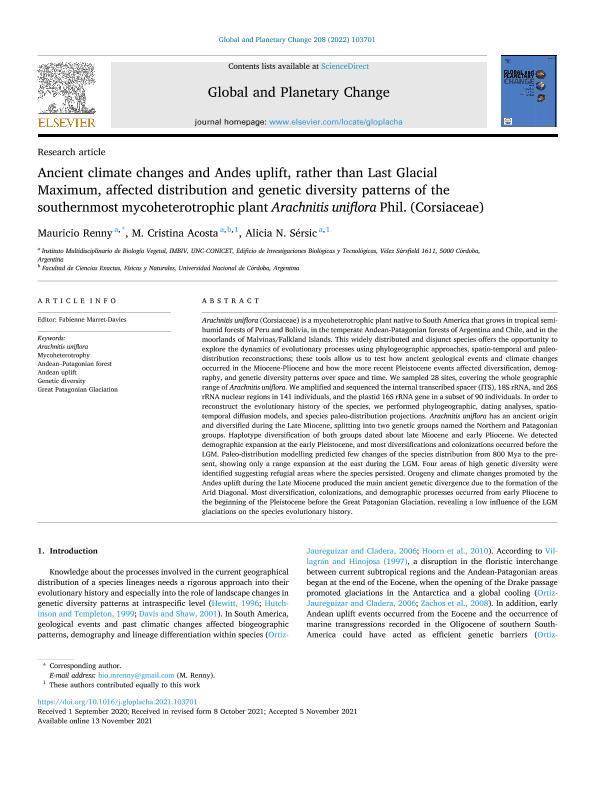Artículo
Ancient climate changes and Andes uplift, rather than Last Glacial Maximum, affected distribution and genetic diversity patterns of the southernmost mycoheterotrophic plant Arachnitis uniflora Phil. (Corsiaceae)
Fecha de publicación:
01/2022
Editorial:
Elsevier Science
Revista:
Global and Planetary Change
ISSN:
0921-8181
Idioma:
Inglés
Tipo de recurso:
Artículo publicado
Clasificación temática:
Resumen
Arachnitis uniflora (Corsiaceae) is a mycoheterotrophic plant native to South America that grows in tropical semi-humid forests of Peru and Bolivia, in the temperate Andean-Patagonian forests of Argentina and Chile, and in the moorlands of Malvinas/Falkland Islands. This widely distributed and disjunct species offers the opportunity to explore the dynamics of evolutionary processes using phylogeographic approaches, spatio-temporal and paleodistribution reconstructions; these tools allow us to test how ancient geological events and climate changes occurred in the Miocene-Pliocene and how the more recent Pleistocene events affected diversification, demography, and genetic diversity patterns over space and time. We sampled 28 sites, covering the whole geographic range of Arachnitis uniflora. We amplified and sequenced the internal transcribed spacer (ITS), 18S rRNA, and 26S rRNA nuclear regions in 141 individuals, and the plastid 16S rRNA gene in a subset of 90 individuals. In order to reconstruct the evolutionary history of the species, we performed phylogeographic, dating analyses, spatio-temporal diffusion models, and species paleo-distribution projections. Arachnitis uniflora has an ancient origin and diversified during the Late Miocene, splitting into two genetic groups named the Northern and Patagonian groups. Haplotype diversification of both groups dated about late Miocene and early Pliocene. We detected demographic expansion at the early Pleistocene, and most diversifications and colonizations occurred before the LGM. Paleo-distribution modelling predicted few changes of the species distribution from 800 Mya to the present, showing only a range expansion at the east during the LGM. Four areas of high genetic diversity were identified suggesting refugial areas where the species persisted. Orogeny and climate changes promoted by the Andes uplift during the Late Miocene produced the main ancient genetic divergence due to the formation of the Arid Diagonal. Most diversification, colonizations, and demographic processes occurred from early Pliocene to the beginning of the Pleistocene before the Great Patagonian Glaciation, revealing a low influence of the LGM glaciations on the species evolutionary history.
Archivos asociados
Licencia
Identificadores
Colecciones
Articulos(IMBIV)
Articulos de INST.MULTIDISCIPL.DE BIOLOGIA VEGETAL (P)
Articulos de INST.MULTIDISCIPL.DE BIOLOGIA VEGETAL (P)
Citación
Renny, Mauricio Eduardo; Acosta, María Cristina; Sersic, Alicia Noemi; Ancient climate changes and Andes uplift, rather than Last Glacial Maximum, affected distribution and genetic diversity patterns of the southernmost mycoheterotrophic plant Arachnitis uniflora Phil. (Corsiaceae); Elsevier Science; Global and Planetary Change; 208; 103701; 1-2022; 1-12
Compartir
Altmétricas




